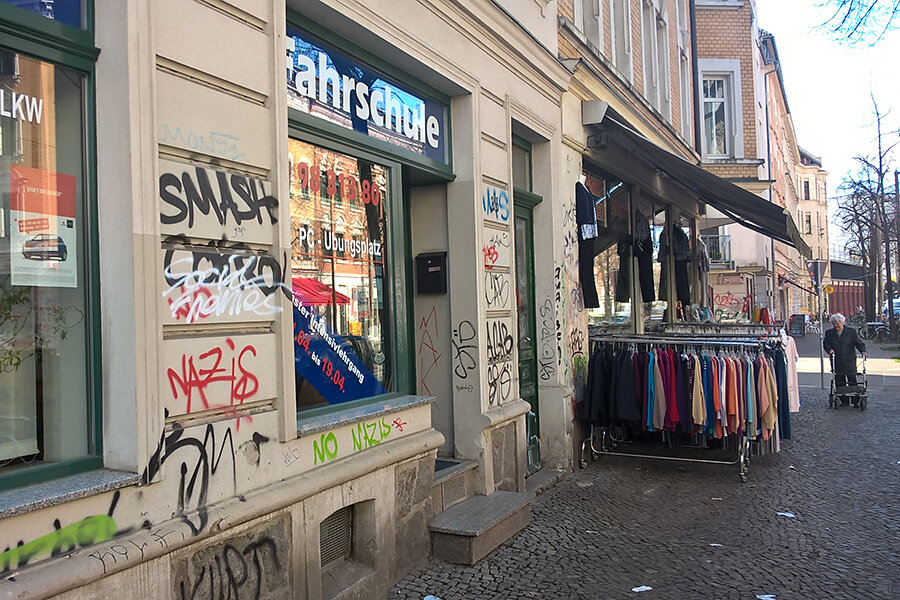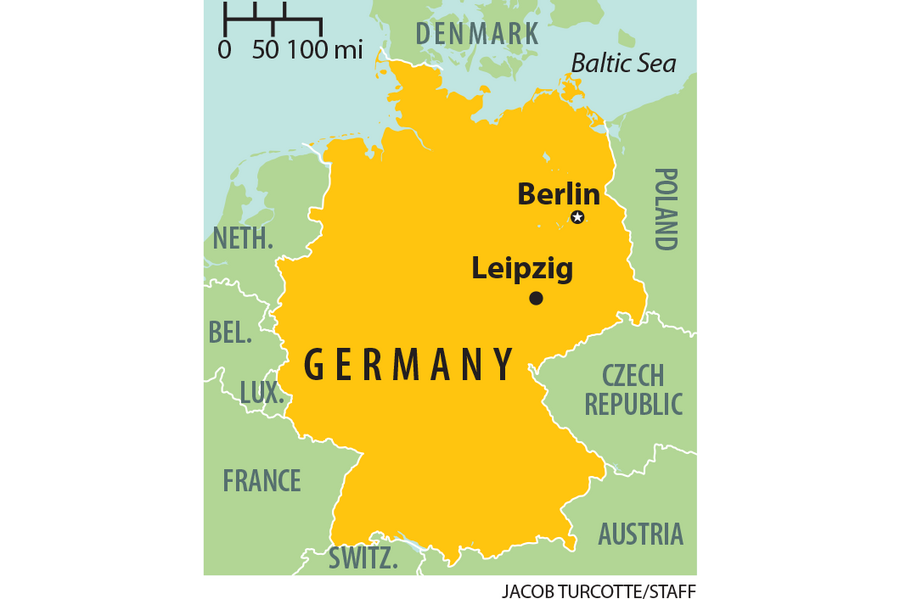As Germany's far right rises, so does its radical left
Loading...
| Leipzig, Germany
Thomas Noack tells anybody that will listen that Connewitz, his neighborhood in this half-million-resident city, is a charming place with lots of ordinary taxpayers, traditional bakeries and butchers, and even a famous Catholic hospital.
But Mr. Noack's vocal enthusiasm for his native home is rooted partially in his frustration with Connewitz's less conventional residents: far-left radicals, known as "autonomists," opposed to the government.
Connewitz is an alternative society, a neighborhood that may be home to many ordinary Leipzigers but whose nationwide reputation is dominated by its many far-left residents. The latter have for years tried to turn Connewitz into an enclave free of government intervention. They have occupied buildings about to be taken over by developers, attacked the city’s administrative office in the neighborhood, and even assaulted its new police station.
And though small in number – just a few hundred by one count – their vocal presence has thrown them back into the political limelight, especially as far-right extremists have gotten louder in Germany amid the refugee crisis and reactionary movements like Pegida. The right-wing radicals take particular delight in squaring off with Connewitz-style extremists, who are themselves fervently anti-Nazi – resulting in street fights and riots, in a kind of microcosm of Western Europe’s political polarization.
“A generation is growing up that has no appreciation of values,” he explains at a Connewitz fair-trade café. “[Connewitz radicals] get unemployment benefits from the government, and when something is stolen they report it to the police, and yet they attack the police station and the unemployment office.... It’s completely illogical.”
The radical left
Though it receives less media coverage than its far-right foe, Germany’s far left is remarkably widespread. According to a recent study by the Free University in Berlin, one sixth of all Germans – and 28 percent of those residing in the former East Germany – hold far-left opinions. And whereas seven percent of Germany’s population support politically motivated violence, 14 percent of far-left and extreme-left Germans do so, according to the Free University study.
“They’re anti-capitalist, they have radical opinions on moral issues such as justice, individual liberty, solidarity, and anti-racism,” explains Dieter Rink, a professor of urban studies at the University of Leipzig and a leading expert on social movements. “In the past, they would have been called anarchists.”
Today, however, they’re commonly referred to as extreme left, and their activities in Connewitz attest to their political opinions. Many live commune-style, in cheap, unrenovated buildings, while others squat in derelict properties to keep developers away. They run Linxxnet, a bookstore and community center (Links is German for left), and its soccer enthusiasts of all ages play for the Roter Stern soccer club. (Roter Stern translates to "red star," a communist symbol.)
Younger residents gather at Conne Island, a community center that features a library, sports facilities, and a practice room for female DJs. Connewitz’s autonomists have even declared an Autonomous Republic of Connewitz.
Connewitz autonomists have long marked their domain by means of graffiti and political stickers, using public spaces to decry various practices. “Stop the Nazis,” one slogan declares, while another one advertises the “Anti-Fascist Street-Fighting Connection.” Yet another popular slogan is ACAB – "All cops are bastards."
And recently autonomists have taken to attacking Connewitz’s two-year-old police station. A particularly vicious attack took place last year, when some 50 autonomists threw Molotov cocktails, rocks, and paint cans at the police station. Two officers doing the night shift narrowly escaped injury but were traumatized.
A foe for the far right
This air of radical-left power has made Connewitz Germany’s preeminent left-wing enclave. But even though they mostly stay in their neighborhood, their left-wing radicalism has made them a particular hate object for right-wing radicals – and made Connewitz a lawless bastion begging to be conquered.
“For right-wing radicals, Connewitz has taken on mythical proportions,” says Sascha Lange, an independent historian in Leipzig who has written a book about Germany’s youth subcultures.
In scenes resembling eastern Germany’s chaotic early 1990s, right-wing radicals rail against Connewitz and sometimes stage marches through the neighborhood. In January, some 250 far-right radicals marched into the neighborhood, smashing windows as they went along. Fortunately, many of the autonomists were in the city center, taking part in a protest against the far-right Pegida movement, so a direct confrontation was avoided.
“Far-right groups are willing to use violence as a political tool,” says Dr. Lange. “When the government doesn’t deal with the far right, the far left says, 'OK, we’ll do it.' That’s what’s happening now.”
Connewitz radicals have also turned up as a volunteer protection force when far right protesters march on halls where asylum seekers live. And when they encounter far-right groups, they use violence.
“The clashes have been going on for six years now, but recently they have become more violent," says Professor Rink. "It’s part of the political polarization in Germany. Pegida has created a pogrom-like atmosphere.” And when the far left and the far right clash, they beat each other up. “It’s man against man,” says Rink. “But unlike the far right, to date the far left hasn’t killed anybody.”
Still, the escalation is alarming. What makes the left-right clash all the more serious is the fact that the radical right is also strong in Saxony, the state where Leipzig lies. And like the Connewitz scene, Saxony's far right attracts supporters from other parts of the country.
Community in Connewitz
For his part, Noack says he has seen far-left radicalism increase in Connewitz over the past several years. But he and other non-radical residents of the neighborhood still try to maintain a normal, convivial atmosphere there. For 24 years now, Connewitz’s churches and locals have organized a street party. Last year, he proudly reports, no less than 70 groups and companies participated.
Noack does have some sympathy for Connewitz radicals worried about gentrification, and suggests a round table where people of all stripes can discuss problems facing Connewitz and Leipzig.
But he has a clear message to the most radical of his neighbors: Anyone who isn't happy with Germany “should simply emigrate.”








